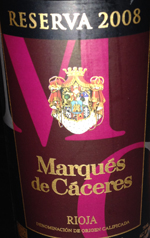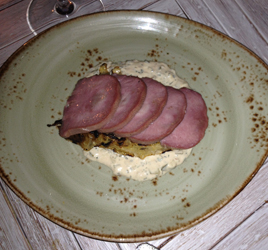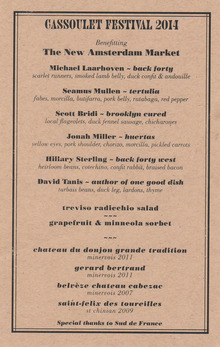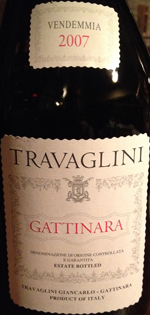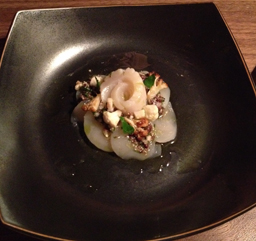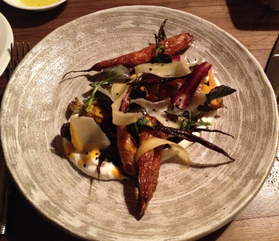Note: This review is under chef Michael Toscano, who left the restaurant in November 2014 for an opportunity in Charleston, South Carolina. Montmartre closed in March 2016. The owner Gabe Stulman, changed the concept over and over again, but couldn’t find a formula that worked.
*
 If Montmartre were an operating system, what version would it be? Best I can tell, we’re on Montmartre v3.0.
If Montmartre were an operating system, what version would it be? Best I can tell, we’re on Montmartre v3.0.
The restaurant opened 13 months ago with ex-Momofuku chef Tien Ho serving classic French bistro cuisine. After just five weeks, Tien and owner Gabe Stulman tossed the menu in lieu of the Asian-inflected Vietnamese cooking that the chef was known for. This was a remarkable turn of events: the restaurant was busy, and none of the pro critics had reviewed it yet. But Stulman apparently smelled a rat before the critics told him what was wrong. When Pete Wells awarded two stars in June 2013, he found v2.0 much improved over version he had beta tested.
 It is less clear what went wrong after that, but Tien left the restaurant in October 2013, and Michael Toscano (Stulman’s partner at Perla) was appointed executive chef and co-owner. Strangely enough, v3.0 reverted back to the plan of v1.0, with a classic French bistro menu. It’s a bit like the failure of New Coke: Coke Classic was better, after all.
It is less clear what went wrong after that, but Tien left the restaurant in October 2013, and Michael Toscano (Stulman’s partner at Perla) was appointed executive chef and co-owner. Strangely enough, v3.0 reverted back to the plan of v1.0, with a classic French bistro menu. It’s a bit like the failure of New Coke: Coke Classic was better, after all.
The new menu is not quite full-on French. Under a heading like Coquillages, you’ve got an offering like Shrimp Cocktail ($15), which basically could be served anywhere. Likewise, under Salades, a choice of Winter Greens ($11) with blood orange vinaigrette. But there’s also escargots ($15) and cassoulet de cochon ($29.50), so there’s enough French for those who want it, along with classic bail-out dishes like a dry-aged burger ($19) and a straight-up roast chicken ($28).
 Appetizers and salads are $11–17, entrées $19 (the burger) up to the oddly priced steak frittes ($35.25). There are a lot of prices ending in .25 or .95, which I have to think is a joke, as it is not consistent, and none of Stulman’s other restaurants—all with a similar vibe and price range—are priced like that.
Appetizers and salads are $11–17, entrées $19 (the burger) up to the oddly priced steak frittes ($35.25). There are a lot of prices ending in .25 or .95, which I have to think is a joke, as it is not consistent, and none of Stulman’s other restaurants—all with a similar vibe and price range—are priced like that.
Despite the humble, and for the most part inexpensive, bistro cuisine, Stulman price-gouges on the wine list, as he always does. There are hardly any reds below $60, and the bottom end is mostly over-priced vins de pays. He really ought to be ashamed of himself. The 2012 Gravilas we ordered was fine, for what it was; it just shouldn’t be $52 (it’s about $17 retail).


We began with country bread, served with soft butter. The amuse bouche (above left) was a butternut squash velouté with hazelnuts. We made the boring but enjoyable choice for our appetizer, a dozen oysters (Wellfleet, Beau Soleil, and Malpeque).

The menu’s obligatory large-format dish is a hulking braised Short Rib Bourgogne pour deux ($60), served with carrots, onions, lardons, and fingerling potatoes. It’s fabulous, and three could easily share it.


Desserts were first rate, a chocolate fondant ($12; above left) and a pineapple clafoutis ($12; above right).


The meal ends with cookies served in an old Camel cigarette case.
The space is resolutely casual, like all of Stulman’s restaurants. The dining rooms on two levels are packed with tables, to what I assume is the legal limit: there was barely room for the food, and we might as well have been in our neighbors’ laps.
Montmartre takes reservations (only by phone), which may indicate some weakness, as historically Stulman has preferred strictly walk-ins. We did exactly that at 7:15pm on a Saturday evening and were seated immediately: they were doing decent business but were not full.
I wish we could have tried more, but the fraction of the menu we were able to sample was excellent. If accompanied by a sensibly-priced wine list, Montmartre might be one of our better French bistros.
Montmartre (158 Eighth Avenue between 17th & 18th Streets, Chelsea)
Food: Excellent Americanized French bistro classics; an over-priced wine list
Service: Good
Ambiance: A charming, if over-crowded, Francophilic dining room on two levels
Rating: ★½
 Sunday, April 13, 2014 at 09:06AM
Sunday, April 13, 2014 at 09:06AM  In what other age could one of the best high-end Greek restaurants in New York, open and go almost totally unnoticed?
In what other age could one of the best high-end Greek restaurants in New York, open and go almost totally unnoticed? Admittedly, there’s not a lot of competition since Michael Psilakis’s Anthos bit the dust. Molyvos is reliable, but not the standout it once was, although it has the city’s best Greek wine list. Milos could be better, but I’ve never been (GQ’s Alan Richman posted a rave in 2010). Thalassa is an old favorite of mine, but it gets very little critical attention; it is still very good, but below its peak.
Admittedly, there’s not a lot of competition since Michael Psilakis’s Anthos bit the dust. Molyvos is reliable, but not the standout it once was, although it has the city’s best Greek wine list. Milos could be better, but I’ve never been (GQ’s Alan Richman posted a rave in 2010). Thalassa is an old favorite of mine, but it gets very little critical attention; it is still very good, but below its peak.















